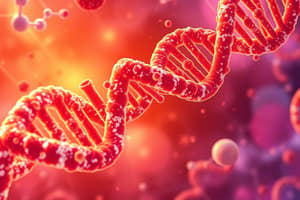Podcast
Questions and Answers
What is the goal of DNA replication?
What is the goal of DNA replication?
To make a second DNA molecule using the parent strands as a template.
Which enzymes are involved in DNA replication? (Select all that apply)
Which enzymes are involved in DNA replication? (Select all that apply)
- DNA helicase (correct)
- DNA polymerase (correct)
- RNA primase (correct)
- DNA ligase (correct)
- RNA ligase
What happens during the initiation phase of translation?
What happens during the initiation phase of translation?
Small ribosomal subunit binds to mRNA at the RBS, and large subunit binds to small subunit.
Explain the difference between +ssRNA and -ssRNA regarding their replication.
Explain the difference between +ssRNA and -ssRNA regarding their replication.
What is an operon?
What is an operon?
Describe the lifecycle of a bacteriophage.
Describe the lifecycle of a bacteriophage.
What direction is DNA read?
What direction is DNA read?
What direction is DNA written?
What direction is DNA written?
Flashcards are hidden until you start studying
Study Notes
DNA Replication
- DNA replication is a semi-conservative process producing two DNA molecules, each consisting of one parent strand and one newly synthesized daughter strand.
- Helicase unwinds the DNA double helix by breaking hydrogen bonds, creating a Y-shaped structure known as the replication fork.
- RNA primase synthesizes an RNA primer, essential for initiating DNA replication on the parent strands.
- DNA polymerase adds nucleotides complementary to the parent strands, working continuously on the leading strand and intermittently on the lagging strand, forming Okazaki fragments.
- DNA ligase joins Okazaki fragments on the lagging strand, creating a continuous daughter DNA strand.
- Single-strand binding proteins stabilize unpaired DNA strands during replication.
Translation Process
- Initiation begins with the small ribosomal subunit binding to mRNA at the ribosomal binding site (RBS), aligning with the start codon in the P-site, followed by the large subunit joining.
- Elongation involves tRNA bringing amino acids to the P-site; peptide bonds form between amino acids as the ribosome moves down the mRNA codon.
- Termination occurs when release factors identify stop codons, leading to ribosome disassembly.
Virus Replication Differences
- Viruses store genetic information in various nucleic acid types, affecting how they are transcribed into mRNA.
- Negative-sense (-ssRNA) viruses require RNA-dependent RNA polymerase to create a positive-sense (+ssRNA) strand for translation.
- Positive-sense (+ssRNA) viruses can directly serve as mRNA for protein translation, also utilizing RNA-dependent RNA polymerase.
- Double-stranded DNA (dsDNA) viruses utilize DNA-dependent DNA polymerase for replication and DNA-dependent RNA polymerase to transcribe viral mRNA.
Operons in Bacteria
- Operons are genetic regulatory systems in bacteria enabling coordinated gene expression.
- An operator controls operon activation; a repressor protein can inhibit transcription, exemplifying negative control.
- The lac operon is an example; in the absence of lactose, the repressor binds the operator to prevent transcription. Allolactose binding to the repressor allows RNA polymerase access for gene transcription.
- The trp operon is a repressible operon that is activated in the presence of tryptophan.
Bacteriophage Lifecycle
- The lifecycle involves phases: adsorption, injection, replication, assembly, and release of new phages.
- The lytic cycle results in the destruction of the host with multiple phage components being synthesized.
- Lysogeny integrates phage nucleic acid into the bacterial genome, allowing the virus to spread without killing the host, thus facilitating survival and persistence.
Glycolysis and Krebs Cycle
- The fate of glucose in glycolysis includes converting it into pyruvate while producing ATP and NADH.
- Pyruvate enters the Krebs cycle, where it undergoes further processing, resulting in ATP, NADH, FADH2, and CO2 as waste products.
- Key inputs of glycolysis include glucose and NAD+, while outputs consist of pyruvate, ATP, and NADH.
- During the Krebs cycle, inputs include acetyl-CoA, and outputs are CO2, ATP, NADH, and FADH2, used in oxidative phosphorylation.
DNA Orientation
- DNA is read in the 3' to 5' direction during replication and transcription.
- DNA is synthesized (written) in the 5' to 3' direction, which aligns with the activities of DNA and RNA polymerases.
Studying That Suits You
Use AI to generate personalized quizzes and flashcards to suit your learning preferences.




